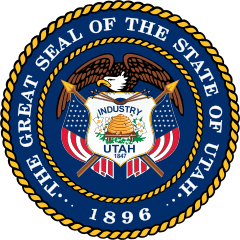Seal of Utah
| Great Seal of the State of Utah | |
|---|---|
 | |
| Versions | |
|
Variant | |
 Coat of arms | |
| Details | |
| Armiger | State of Utah |
| Adopted | April 3, 1896 |
| Motto | Industry |
The Great Seal of the State of Utah was adopted on April 3, 1896, at the first regular session of the Legislature (January, February, March, April 1896). The original seal was designed by Harry Edwards and cost $65.00. The great seal is described in Utah Code Annotated, 1953, Volume 7a, section 67-2-9 as follows:
"The Great Seal of the State of Utah shall be two and one-half inches in diameter, and of the following device; the center a shield and perched thereon an American Eagle with outstretching wings; the top of the shield pierced by six arrows crosswise; under the arrows the motto "INDUSTRY"; beneath the motto a beehive, on either side growing sego lilies; below the figures "1847"; on each side of the shield an American Flag.; encircling all, near the outer edge of the seal, beginning at the lower left-hand portion, the words, "THE GREAT SEAL OF THE STATE OF UTAH", with the figures "1896" at the base."
Seal of the Governor
.svg.png)
There is also an official seal of the Governor of Utah. Borrowing most of the same symbolism from the state seal, the Governor's seal includes Roman numerals at the bottom, which represent the Governor himself, and this changes with every new Governor. Each Governor therefore has a seal unique to themselves and their administration. The Roman numerals are currently "XVII", representing Gary Herbert, who is the 17th governor of Utah since statehood.
Enhanced Variant
An artist at the Colonial Flag Company, produced the artwork for the corrected Utah State flag used during the Legislative process. The flag was drawn following the legal description and using the colors of the flag made for presentation to the USS Utah in 1912. Although colors were not included in the law describing the Utah State Flag as adopted in 1912 and amended in 1913, they were described in other state documents. Utah officials asked that those colors be used. However, they declined to include an illustration with the House Concurrent Resolution, saying that was not possible.
As with many flags with seals and coats of arms, there is room for artistic interpretation while still following correct designs. Paul Swenson, who as the President of Colonial Flag Company had paid for the prototype design, felt the eagle as shown in that design was weak and unattractive. He had graphic artist Perry Van Schelt strengthen the design while following the same description and using the same colors as employed in the prototype. Both the prototype and the enhance designs are correct and follow the law and intent of the 2011 legislation. Only a few hundred flags were ordered using the prototype design, and most flags now being made and sold use the enhanced design, but legally flag manufacturers are free to use either version. [1]
-
.svg.png)
Coat of arms of Utah (enhanced variant) -
.svg.png)
Flag of Utah (enhanced variant) -
.svg.png)
Seal of Utah (enhanced variant) -
.svg.png)
Seal of the Governor of Utah (enhanced variant) -
.svg.png)
Seal of Utah (alternative, enhanced variant)
Symbolism
| Symbol | Meaning |
| American eagle | National bird |
| Shield | Common defense |
| Industry | Motto |
| Beehive | State emblem |
| 1896 | Statehood established |
| 1847 | Pioneers arrived |
| Sego Lily | State flower |
| American flags | National government |
See also
References
External links
| ||||||||||||||||||||||||||||||
_2011.svg.png)
.svg.png)